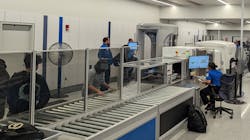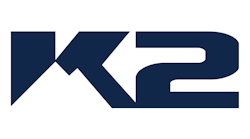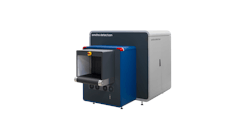New Carry-On Baggage Screening System Aims to Reduce Traveler Screening Times
Travelers may have a new way to screen their carry-on bags in the future with technology being developed by the Department of Homeland Security (DHS) Science and Technology Directorate (S&T). S&T recently installed a next generation carry-on baggage screening system at Boston Logan International Airport in Massachusetts to collect data about how the system operates in a real-world environment to improve the system and detection algorithms. The system, administered by S&T’s Screening at Speed Program, is intended to help the Transportation Security Administration (TSA) cut the number of false alarms during carry-on bag screenings and reduce the time passengers spend in line waiting for their bags to be cleared.
“This new carry-on screening system is an important next step in aviation security,” said Dr. John Fortune, S&T’s Screening at Speed Program Manager. “It combines two state-of-the-art systems into a hybrid that outperforms what the systems can do on their own. This data collection will help us fine tune the Automatic Threat Recognition (ATR) algorithm and take advantage of the system’s ability to know which objects in our carry-on bags are actual threats and which just look like threats.”
The two systems in this hybrid are the Computed Tomography (CT) X-ray, like the technology used in CAT-scans, and the newer X-Ray Diffraction (XRD). The XRD system provides more information about the types of materials in bags than CT X-ray and, in some cases, can identify what objects are made of in carry-on bags. Together, the two systems allow Transportation Security Officers (TSOs) to view a 3D image of the bag, identify materials inside, and recognize whether there is a threat without having to open it, reducing the number of bag inspections and speeding up the process at the checkpoint.
“TSA is focused on making air travel as safe as possible while improving the passenger experience through security checkpoints,” said Bob Allison, TSA’s Federal Security Director for Massachusetts. “This new technology would also improve screening methods and daily workflows for our TSOs who are on the front lines of aviation security. Technologies like the hybrid CT/XRD system allows us to bring those goals together in a single system.”
TSA is conducting testing from now through most of May. The developers, Integrated Defense Security Solutions (IDSS) and Halo X-ray Technologies, aim to gather 10,000 bag scans. After the event, IDSS will use the data to improve the system’s ATR algorithm over the next six months. Once the algorithm upgrade is delivered to Screening at Speed, there is a further opportunity to conduct additional data collection over the next two years to get the system ready for certification testing before the technology is transitioned to TSA.
The Screening at Speed Program conducts transformative research and development to improve the traveler experience, ensure security systems development out paces evolving threats, and realize the aviation experience of the future.


